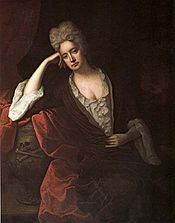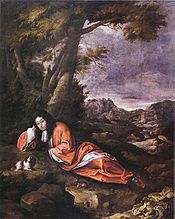Garret Morphy facts for kids
Garret Morphy (also spelled Morphey or Morphew) was an important Irish painter. He lived from about 1655 to 1716. Many people think he was Ireland's very first professional artist. This means he made a living just from painting!
His Early Life
We don't know much about where Garret Morphy came from. We also don't know a lot about his personal life. Most people believe he was born in Ireland. However, there were families named Morphy in London and Dublin back in the 1600s.
When he made his will, he was called "of the city of Dublin, painter." The first time we see his name in official papers was in 1673. At that time, he was helping another Catholic artist named Edmund Ashfield in London. He was probably around 18 years old then.
What He Painted
Garret Morphy's first known paintings are from around 1676. The way he painted portraits suggests he learned from a Flemish artist. This artist was named Gaspar Smitz. Smitz painted important Irish families in the 1660s and 1670s.
Morphy was a Catholic. He often traveled between London and Dublin. He painted portraits of well-known Catholic families. He also painted important government officials and army officers. It's thought he might have visited the Netherlands and France. This is because his paintings showed the newest art styles of that time. Morphy seemed to move around a lot. This makes it hard to know how much time he spent in Ireland.
He painted a portrait of Oliver Plunket. Plunket was a Catholic Archbishop of Dublin. He was executed in 1681. Morphy was in Yorkshire and Northumberland between 1685 and 1688. During this time, he painted the Duke of Newcastle and others. He was a very fast painter and made many portraits.
His work is important because he captured how powerful families looked. These families were facing big changes in Irish history. Around 1689, he came back to Ireland. He spent time with families like the O'Neills and the Talbots. Many people Morphy painted later lost their land. This happened during the Williamite War. After this war, Morphy started getting painting jobs from Protestant landowners.
His Unique Style
Morphy used a quick painting style. This made the faces of the people he painted look soft. We know of at least 70 portraits from his studio. He painted these over 30 years.
When he painted women, they often had the same pose. Their head would rest on their right hand. They would have a "dreamy gaze." Men in his paintings often had their body turned away from the viewer. Their right hand would be across their chest.
His Lasting Impact
Garret Morphy passed away between November 1715 and May 1716. His will was officially approved on May 12, 1716. His nephew, Edmond Moore, likely took over his painting studio.
People say that Garret Morphy made Irish portrait painting much better. He brought it to a new, professional level.
Some of his paintings are now in famous places. You can see them at the National Gallery of Ireland. Others are in the National Portrait Gallery in London.



